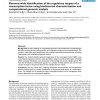BMCBI
2005
13 years 4 months ago
2005
Background: With the exponential increase in genomic sequence data there is a need to develop automated approaches to deducing the biological functions of novel sequences with hig...
BMCBI
2005
13 years 4 months ago
2005
Background: A major challenge in computational genomics is the development of methodologies that allow accurate genome-wide prediction of the regulatory targets of a transcription...
BMCBI
2005
13 years 4 months ago
2005
Background: In the clinical context, samples assayed by microarray are often classified by cell line or tumour type and it is of interest to discover a set of genes that can be us...
BMCBI
2005
13 years 4 months ago
2005
BMCBI
2005
13 years 4 months ago
2005
Background: The evaluation of statistical significance has become a critical process in identifying differentially expressed genes in microarray studies. Classical p-value adjustm...
BMCBI
2005
13 years 4 months ago
2005
Background: Different classes of haplotype block algorithms exist and the ideal dataset to assess their performance would be to comprehensively re-sequence a large genomic region ...
BMCBI
2005
13 years 4 months ago
2005
Background: Protein sequence motifs are by definition short fragments of conserved amino acids, often associated with a specific function. Accordingly protein sequence profiles de...
BMCBI
2005
13 years 4 months ago
2005
Background: Multiple genome alignment is an important problem in bioinformatics. An important subproblem used by many multiple alignment approaches is that of aligning two multipl...
BMCBI
2005
13 years 4 months ago
2005
Background: Recent studies have shown that the patterns of linkage disequilibrium observed in human populations have a block-like structure, and a small subset of SNPs (called tag...
BMCBI
2005
13 years 4 months ago
2005
Background: Human heart failure is a complex disease that manifests from multiple genetic and environmental factors. Although ischemic and non-ischemic heart disease present clini...





